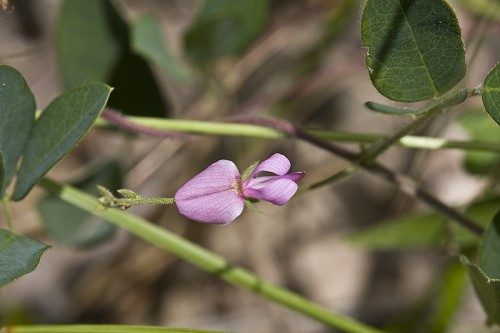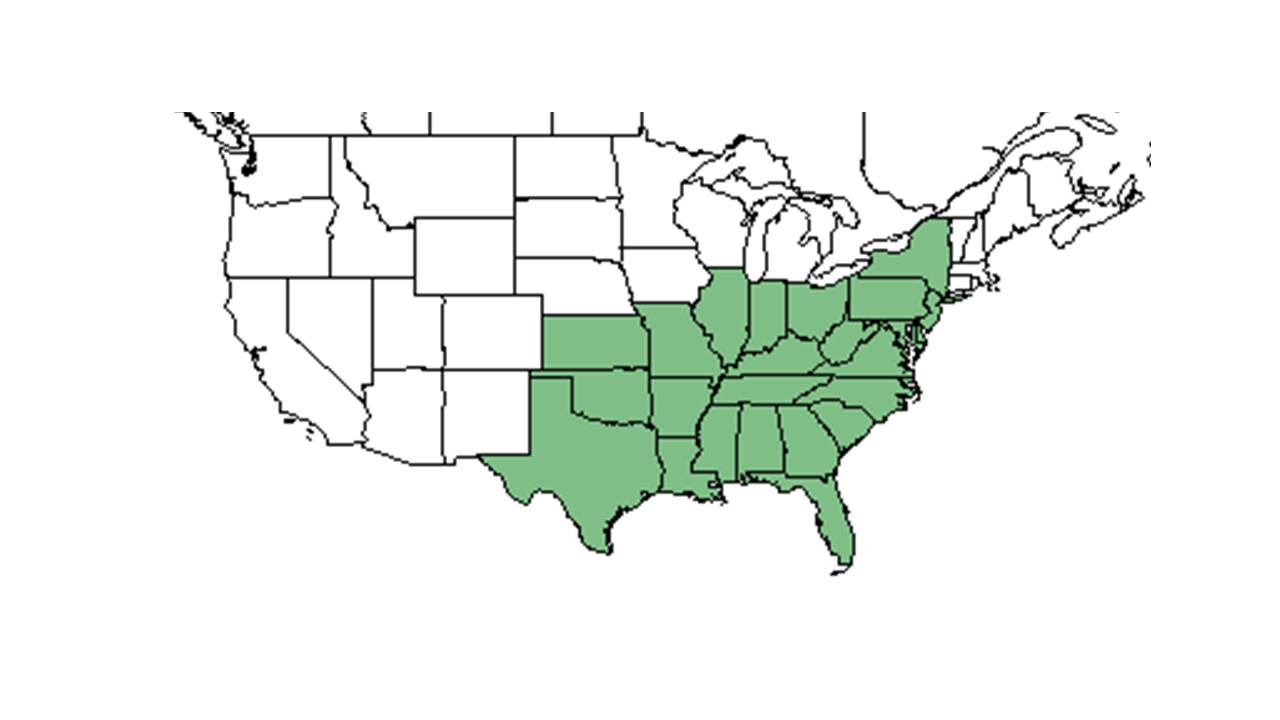Galactia volubilis
| Galactia volubilis | |
|---|---|

| |
| Photo by John R. Gwaltney, Southeastern Flora.com | |
| Scientific classification | |
| Kingdom: | Plantae |
| Division: | Magnoliophyta - Flowering plants |
| Class: | Magnoliopsida – Dicotyledons |
| Order: | Fabales |
| Family: | Fabaceae ⁄ Leguminosae |
| Genus: | Galactia |
| Species: | G. volubilis |
| Binomial name | |
| Galactia volubilis (L.) Britton | |

| |
| Natural range of Galactia volubilis from USDA NRCS Plants Database. | |
Common name: downy milkpea
Contents
Taxonomic notes
Description
This species is a climbing vine with twining behavior (FSU Herbarium).
Generally, the genus Galactia are "trailing or twining, climbing, perennial, herbaceous or woody vines or erect, perennial herbs or rarely shrubs. Leaves 1-pinnate, usually 3-foliolate (or rarely 1-,5-7-,9-folilolate); leaflets entire, petiolulate, stipellate. Racemes axillary, pedunculate with few to numerous, papilionaceous flowers borne solitary or 2-several at a node, ech subtended by a bract and fusion of the 2 uppermost, with the laterals usually shorter than the uppermost and lowermost; petals usually red, purple, pink or white; stamens diadelphous or elsewhere occasionally monadelphous; ovary sessile or shortly stipitate. Legume oblong-linear to linear, few-many seeded, compressed, straight or slightly curbed, dehiscent with often laterally twisting valves."- Radford et al 1964
Specifically, for this species, G. volubilis, they are "twining, climbing, herbaceous vines with sparsely to densely, spreading pubescent stems, 1-1.5 m long. Leaves 3-foliolate, rachis 2-18 mm long; leaflets narrowly to widely oblong, oblong-ovate or elliptic, (1) 2-4 (6) cm long, glabrous, or nearly so, above and glabrate to more commonly appressed short-pubescent to spreading pilose beneath. Racemes with peduncles and rachises sparsely to densely spreading short-pubescent, 3-15 (30) cm long; flowers 1-3 at each node on spreading short-pubescent pedicles 1-4 mm long subtended by triangular bracts 0.4-1.2 mm long; bractlets triangular, 0.4-1 mm long. Calyx spreading short-pubescent, tube 2-2.5 mm long, lobes 2-3.5 mm long; petals pink to roseate, the standard 7-10 mm long. Legume 2-5.5 cm long, 4-5 mm broad, densely spreading short-pubescent." - Radford et al 1964
Distribution
“…occurring in sandy soils from New York to Florida westward to Tennessee and Texas.”[1]
Ecology
Habitat
This species is found in mixed hardwood forests, pinewoods, shrub and herb dominated communities, old fields, ravine dissected areas, dry pocosins, flatwoods, creek banks and savannahs (FSU Herbarium). It has been observed to grow in dry and moist sandy loam in open areas with full sunlight (FSU Herbarium). G. volubilis has also been seen growing in areas disturbed by humans such as bulldozed scrub sandhills, along roadsides, cleared sites, and clear cut longleaf pine-scrub habitats (FSU Herbarium). Associated species include Desmodium ochrolecum, D. rotundifolium, Rhus aromatica, Centrosema species, Paspalum species, Fagus species, Carya tomentosa, Pinus palustris, Pinus elliottii, Quercus laurifolia, Quercus virginiana, Quercus laevis, Sabal palmetto, Magnolia ashei, Aristida stricta. Galactia regularis, Rhynchosia difformis, Setaria, Phlox, and Cuphea. Also includes Broomsage and Silver palm (FSU Herbarium).
Phenology
“A lavender-flowered prostrate perennial herb frequently climbing over bushes...It is variable species and varietal forms have been described”[1] This species has been observed to flower from May through September and November and fruiting from May to November (FSU Herbarium).
Seed dispersal
Seed bank and germination
Fire ecology
The amount of G. volubilis decreased after a spring burn, summer burn, and in the control plot[2] “Results from previous studies[3] indicate that leguminous plants and seed respond best to “hot” fires such as those in which a high proportion of the ground fuel is consumed. Laboratory tests[4] have also shown that seed from several leguminous species germinate best after scarification with moist heat at temperatures near 80 degrees C., a situation requiring a hot fire. The response of the leguminous plants and seed in this study, therefore, would probably have been greater if the pine stands had been burned with more intense fires. ”[2] G. volubilis had the greatest coverage on the plots burned in January at the loblolly-shortleaf pine communities of the Alabama upper coastal plain.[5] This species has also been found in areas that were excluded from fire (FSU Herbarium).
Pollination
Use by animals
Eastern mourning dove includes G. volubilis in its diet.[1]
Diseases and parasites
Conservation and Management
Cultivation and restoration
Photo Gallery
References and notes
Florida State University Robert K. Godfrey Herbarium database. URL: http://herbarium.bio.fsu.edu. Last accessed: June 2014. Collectors: Loran C. Anderson, Gary R. Knight, Richard S. Mitchell, R.K. Godfrey, L. M. Baltzell, O. Lakela, J. Ferborgh, Jane Brockmann, R. W. Long, L. J. Brass, H. A. Lang, C. Jackson, A. F. Clewell, R. C. Phillips, R. Kral, M. Davis, Richard R. Clinebell II, R. L. Wilbur, W. B. Fox, R. Komarek, J.M. Kane, Chris Cooksey, Kevin Oakes, Charles S. Wallis, John B. Nelson, and D.E. Kennemore. States and Counties: Florida: Citrus, Dade, Duval, Escambia, Gulf, Franklin, Hardee, Hernando, Hillsborough, Jackson, Jefferson, Leon, Levy, Monroe, St. Lucie, Taylor, and Wakulla. Georgia: Grady, McIntosh, and Thomas. North Carolina: Craven and Cumberland. Oklahoma: Latimer. South Carolina: Orangeburg and Richland.
Radford, Albert E., Harry E. Ahles, and C. Ritchie Bell. Manual of the Vascular Flora of the Carolinas. 1964, 1968. The University of North Carolina Press. 643-4. Print.
- ↑ 1.0 1.1 1.2 Graham, E. H. (1941). Legumes for erosion control and wildlife. Washington, USDA
- ↑ 2.0 2.1 Cushwa, C. T., M. Hopkins, et al. (1970). Response of legumes to prescribed burns in loblolly pine stands of the South Carolina Piedmont. Asheville, NC, USDA Forest Service, Research Note SE-140: 6.
- ↑ Cushwa, C. T., Czuhai, Eugene, Cooper, R. W., and Julian, W. H. 1969. Burning clearcut openings in Loblolly pine to improve wildlife habitat. Ga. Forest Res. Count. Res. Pap. 61, 5 pp. Cushwa, C. T. and Redd, J. B. 1966. One prescribed burn and its effects on habitat of the Powhatan Game Management Area. Southeast. Forest Exp. %a., U. S. Forest Serv. Res. Note SE-61, 2 pp.
- ↑ Cushwa, C. T., Martin, R. E., and Miller, R. L. 1968. The effects of fire on seed germination. J. Range Manage. 21: 250-254. M a r t i n , R . E., a n d C u s h w a , C . T. 1966. Effects of heat and moisture on leguminous seed. Fifth Annu. Tall Timbers Fire Ecol. Conf. Proc. 1966: 159-175.
- ↑ Moore, W. H. (1958). "Effects of certain prescribed fire treatments on the distribution of some herbaceous quail food plants in loblolly-shortleaf pine communities of the Alabama upper coastal plain." Proceedings of the Annual Conference of the Southeastern Association of Game and Fish Commissioners 11: 349-351.